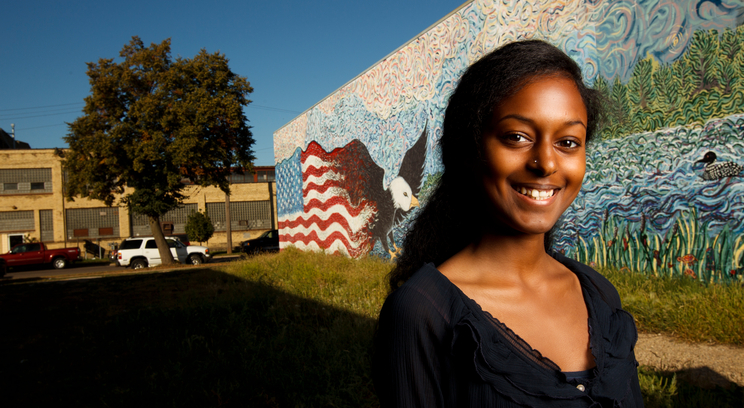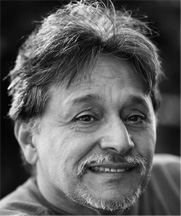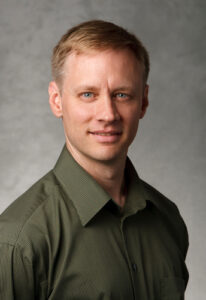While a student at Minneapolis' South High School, junior Heaven Fekadu had seen local artist Jimmy Longoria's urban murals splashed across buildings in her neighborhood. But it he wasn't until he spoke at St.Thomas last spring that she saw an opportunity to work with the artist.
Intrigued by his work, Fekadu called him directly to ask if he'd speak to her "Conflict Resolution" class that semester. He accepted, and this past summer she worked with him on her self-designed project: "Mentoring Peace Through Art: Empowering Urban Youth Through Street Murals.” The project was funded by the Ronald E. McNair Post-baccalaureate Achievement Program at St. Thomas.
"I was in a unique position to research this project because I graduated from the same school and came from the same neighborhood as some of the youth involved in the mural painting," Fekadu said.
The title of her project comes from Longoria’s Mentoring Peace Through Art, a nonprofit that Longoria – the only Chicano/Latino/Hispanic to be awarded a Bush Foundation Artist Fellowship − cofounded with his wife, Connie Fullmer. The organization mentors youth as a way to identify, engage and develop leadership potential in young individuals through art projects that serve the social needs of diverse communities.
Those needs frequently involve painting over gang graffiti used to mark their territories on the exterior walls of local businesses.
Dr. Mike Klein, a justice and peace studies professor at St.Thomas and Fekadu’s project adviser, described her project: “Heaven engaged in excellent work as a qualitative researcher, blending interviews, observations and documentary research into a coherent narrative. Her case study of Longoria's mural work documents an innovative project addressing local drug trafficking, youth leadership and murals that represent youth voices while beautifying Minneapolis neighborhoods.”
Gang symbols can appear deceptively nondescript – Fekadu drew an example of one local gang’s marking: three dots in the shape of a triangle. But a gang’s symbol, no matter how simple in design, carries dire consequences for the surrounding neighborhood if not removed.
“The murals don’t fix the gang problem, but they help disperse the dangerous problems, such as drug trafficking, that gangs bring to communities,” Fekadu explained. "They're not going to do business in front of this enormous, colorful mural that attracts attention. These murals take the walls away from the gangs by painting over the tags (or symbols) that they use to claim their territory."
She also noted that the impressionistic style of Longoria’s murals, which “pack as much color into many strokes,” and the clear latex coat he applies to every finished mural make it difficult for gangs to write over the murals and for their symbols to be clearly seen.
Fekadu employed ethnographic methodology in her research, which she described as “qualitative versus quantitative, and rooted in field research … mostly observation that’s participatory in nature and interviews.” She spent the first eight weeks of the summer researching Longoria's mural sites and observing him and his volunteers at work.
She laughed when asked if she had any art training then remarked that the best part of her ethnographic research, which is, by its nature, immersion-focused, was helping to paint five murals in south Minneapolis. Throughout high school, she always felt an inclination toward art but never pursued it, so his project was a welcome blend of a fond childhood pastime and her career ambitions as an adult.
It was through this lens that she came to “a new understanding of community and what it means to help urban youth,” she noted. “This is not your typical art where you pay for it at the register and plant it on your wall. There’s a lot of interaction in this kind of art, not just among the volunteers, but among the communities that it serves. People would stop by while we painted, and you could tell they were really excited by what we were doing.”
She added, “What’s also really important is that this plays into solutions for getting youth in the area involved in shaping their community − getting them involved so they have a sense of being represented and a sense of ownership in where they live.”
Fekadu plans on applying to a Ph.D. program, possibly overseas. She will spend her last two years at St. Thomas "figuring out what I want to focus on, but I'm interested in cultural anthropology or sociology programs. And I've always seen myself working in the Third World," she said.









